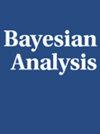带协方差的后处理后验算子
IF 4.9
2区 数学
Q1 MATHEMATICS, INTERDISCIPLINARY APPLICATIONS
引用次数: 4
摘要
我们考虑了带状协方差矩阵的贝叶斯推理,并提出了一个后处理后验。后验的后处理包括两个步骤。第一步,从不满足任何结构限制的共轭逆- wishart后验中获得后验样本。第二步,通过后处理函数对后验样本进行变换以满足结构约束。概念上简单明了的后处理后验过程使其计算效率高,并且可以给出协方差矩阵泛函的区间估计。我们表明,在所有可能的先验和后处理函数对之间,它具有几乎最优的带状协方差极小极大率。此外,我们证明了后处理后验的$(1-\alpha) 100% $最高后验密度区域相对于传统后验分布的期望覆盖概率渐近$1-\alpha$。这意味着,平均而言,后处理后验的最高后验密度区域是常规后验的可信集。通过仿真研究和实际数据分析,证明了后处理后验的优越性。本文章由计算机程序翻译,如有差异,请以英文原文为准。
Post-Processed Posteriors for Banded Covariances
We consider Bayesian inference of banded covariance matrices and propose a post-processed posterior. The post-processing of the posterior consists of two steps. In the first step, posterior samples are obtained from the conjugate inverse-Wishart posterior which does not satisfy any structural restrictions. In the second step, the posterior samples are transformed to satisfy the structural restriction through a post-processing function. The conceptually straightforward procedure of the post-processed posterior makes its computation efficient and can render interval estimators of functionals of covariance matrices. We show that it has nearly optimal minimax rates for banded covariances among all possible pairs of priors and post-processing functions. Furthermore, we prove that the expected coverage probability of the $(1-\alpha)100\%$ highest posterior density region of the post-processed posterior is asymptotically $1-\alpha$ with respect to a conventional posterior distribution. It implies that the highest posterior density region of the post-processed posterior is, on average, a credible set of a conventional posterior. The advantages of the post-processed posterior are demonstrated by a simulation study and a real data analysis.
求助全文
通过发布文献求助,成功后即可免费获取论文全文。
去求助
来源期刊

Bayesian Analysis
数学-数学跨学科应用
CiteScore
6.50
自引率
13.60%
发文量
59
审稿时长
>12 weeks
期刊介绍:
Bayesian Analysis is an electronic journal of the International Society for Bayesian Analysis. It seeks to publish a wide range of articles that demonstrate or discuss Bayesian methods in some theoretical or applied context. The journal welcomes submissions involving presentation of new computational and statistical methods; critical reviews and discussions of existing approaches; historical perspectives; description of important scientific or policy application areas; case studies; and methods for experimental design, data collection, data sharing, or data mining.
Evaluation of submissions is based on importance of content and effectiveness of communication. Discussion papers are typically chosen by the Editor in Chief, or suggested by an Editor, among the regular submissions. In addition, the Journal encourages individual authors to submit manuscripts for consideration as discussion papers.
 求助内容:
求助内容: 应助结果提醒方式:
应助结果提醒方式:


